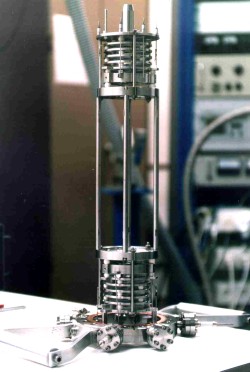Trapped Ions Stick Together

The discovery was made by Daniel Zajfman and his colleagues at the Weizmann Institute of Science in Rehovot, Israel. Their ion trap consists of a 40-cm-long tube with a set of electrodes at either end. The electrodes create electric fields that act as “mirrors,” causing the ions to bounce back and forth. Each time they are reflected, the ions pass through a ring at the center of the machine that detects them via induction.
The Weizmann team wanted to use this trap to determine the ions’ masses. They knew that a cloud of light ions would oscillate faster than one of heavy ions, and they hoped to find the masses from the frequency of those oscillations. But the researchers expected there would be limits to the accuracy of their frequency measurements. “We knew that it would be of limited use because the ion bunch would spread,” says Zajfman. Differences in individual velocities and trajectories would cause the ions to spread out over the course of numerous reflections. More importantly, their positive charges would push them apart. But when the team fiddled with the electrode voltages, they made a discovery: In some cases, the ions would stick together indefinitely. “Our first reaction was, ‘That’s impossible,’” Zajfman recalls. “Then we had to scratch our heads and try to understand it.”
Zajfman and his colleagues now believe that the repulsion among ions actually holds the cloud together. As the cloud races down the length of the trap, it spreads out because individual ions are moving at different velocities. At the end of the trap, electric fields focus the ions into the heart of an electrostatic mirror. Inside the mirror, the fast and slow ions come together, and then their mutual repulsion pushes them apart. During the squeeze and push, the fast ions give the slow ones some of their momentum, so that the reflected cloud is tightly packed as it leaves the mirror. The net effect is that the group can travel back and forth many more times than the researchers had predicted.
Because the cloud holds together over many trips, the team was able to get extremely accurate measurements of the frequency, which gave the mass of the ions. Zajfman claims the measurements could be as accurate as those of the world’s most sophisticated mass spectrometers. “The potential resolution is impressive,” agrees John Bollinger of the National Institute of Standards and Technology in Boulder, CO, but he adds that further research will be needed to establish the accuracy of such a device. Nevertheless, Zajfman is optimistic. “I think there’s a real possibility here,” he says, “for a simple effect in physics to have an immediate application.”
–Geoff Brumfiel


